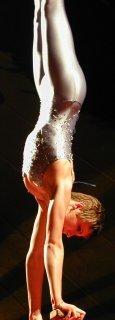The Circus
Today, we go to a circus. The University of Houston's College of Engineering presents this series about the machines that make our civilization run, and the people whose ingenuity created them.
I got up at four o'clock one summer morning back in 1944 and bicycled off to the fairgrounds. I'd heard that if you helped put up the circus you'd get free tickets. Roustabouts were already at it when I got there. With hardly a word, I was put to the backbreaking labor of setting up bleachers.
Around me circus professionals, humans and elephants alike, put their shoulders to the task. Six men with sledgehammers surrounded a single anchor for the big tent. One swung his sledge, then the next. They started a slow chant, picked up the rhythm and, for a moment, hammer blows rained down like a machine gun fire. The men circled an acre of ground, pounding post after post. Through the morning and into the afternoon the circus rose about our heads while I violated every canon of Child Labor law.
In the mid-afternoon I wobbled home with two tickets for the evening show. I took my mother, and it was fun; but I was past exhaustion and remember almost nothing of the evening. No matter, I'd seen the real circus with all its tatty texture and imagery.
In one sense the circus is millennia old. The word circus comes from the Latin word for circle -- a vestige of the old Roman arenas. And today's circuses are going hi-tech with fancy sound, light, and indoor auditoriums.
What I'd seen that day, over a half-century ago, was a creature that came long after Rome and which is, by now, largely gone. The circus of the big top -- the circus young boys ran away from home to join -- that was an 18th-century creature. Howard Loxton's recent book The Golden Age of the Circus traces the idea to an Englishman, Philip Astley, who created a horse-riding show in 1768.
After trick riding he added "educated" pigs and dogs. Human acrobats followed. But animals remained at the heart of the show. By 1791 most elements of the classical circus were in place: rope walkers, lions, tigers, clowns, and every kind of horse riding.
Astley and a competitor named Hughes took their shows to Europe. Europe seized on the idea and began developing it. Here in America George Washington enjoyed his first circus at least as early as 1793. Astley had called his show Scenes of the Circle, and general use of the word circus followed around 1800.
 P.T. Barnum, born in 1810, spent most of his life mounting exotic shows. He didn't get into the circus business till he was over fifty. It was 1884 before the Ringling Brothers started their first circus. But now the classical circus was fully evolved. A full railroad train had spilled the pieces of a Ringling Brothers' circus out on to the fairgrounds before sunup that day in 1944.
P.T. Barnum, born in 1810, spent most of his life mounting exotic shows. He didn't get into the circus business till he was over fifty. It was 1884 before the Ringling Brothers started their first circus. But now the classical circus was fully evolved. A full railroad train had spilled the pieces of a Ringling Brothers' circus out on to the fairgrounds before sunup that day in 1944.
Now I look at the modern spawn of the old circus -- the superb theater of the Cirque du Soleil. Barnum's new Kaleidoscape "circus". What's missing? I suppose it has to be the manure, the rancid popcorn shady characters, young boys and elephants worked to their limit. Great art is always born in vulgarity, and that's what's gone. All that wonderful multicolored vulgarity.
I'm John Lienhard, at the University of Houston, where we're interested in the way inventive minds work.
(Theme music)
Loxton, H., The Golden Age of the Circus, London: Regency House Publishing, 1997.
